
Geoffrey O'Hara was a Canadian American composer, singer and music professor.

"K-K-K-Katy" is a World War I-era song written by Canadian American composer Geoffrey O'Hara in 1917 and published in 1918. The sheet music advertised it as "The Sensational Stammering Song Success Sung by the Soldiers and Sailors", as well as "The Sensational New Stammering Song" The song was first played at a garden party fund-raiser for the Red Cross in Collins Bay on Lake Ontario. O'Hara was from Chatham, Ontario, and taught music at several universities.
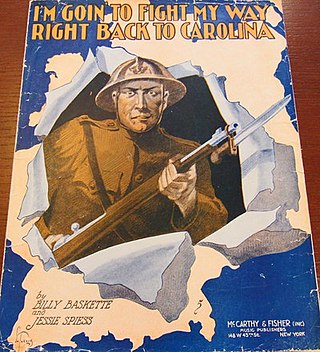
"I'm Goin' To Fight My Way Right Back to Carolina" is a World War I era song written and composed by Billy Baskette and Jessie Spiess. The song was published in 1918 by McCarthy & Fisher, Inc. of New York City. The sheet music cover was designed by Andre C. De Takacs. It features an armed soldier tearing through the cover. The song was written for both voice and piano.
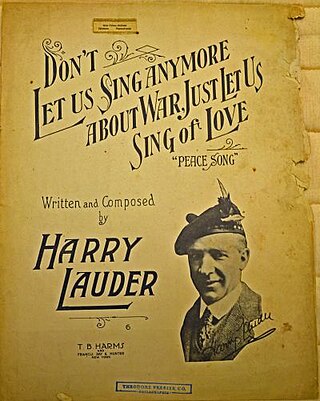
"Don't Let Us Sing Anymore About War, Just Let Us Sing of Love " is a World War I era song released in 1918. Lyrics and music were written by Harry Lauder. It was published by T.B. Harms and Francis, Day & Hunter, Music Co. of New York, New York. The sheet music cover features a photo of Lauder with his autograph. The song was written for both voice and piano.
"We're Going Over the Top" is a World War I song written by Andrew B. Sterling, Bernie Grossman, and Arthur Lange. It was published in 1917 by Joe Morris Music Co., in New York, NY. The sheet music cover, designed by Starmer, illustrates a battlefield scene with a tank moving over the top of a trench and soldiers inside the trench getting out of the way of the tank. Behind the tank soldiers march up the field.

General Pershing: is a march composed in 1918 by Carl D. Vandersloot and published by Vandersloot Music Publishing Company.

Don't Cry Frenchy, Don't Cry is a 1919 song written during World War I. The lyrics were written by Sam M. Lewis and Joe Young, and the music was written by Walter Donaldson.The song was published by Waterson, Berlin & Snyder Company in New York City.
"It Won't Be Long Before We're Home" is a World War I song in the style of a march. It was written by Paul Cunningham and composed by Joseph E. Howard. This song was published in 1918 by M. Witmark & Sons, in New York, NY.

"Keep Your Head Down, Fritzie Boy" is a World War I song written and composed by Gitz Rice. This song was published in 1918 by Leo. Feist, Inc., in New York, NY. The cover features a photo of Gitz Rice and reads "inspired by a brave Tommy and written at the Battle of Ypres, 1915."
"The Dixie Volunteers" is a World War I song written and composed by Edgar Leslie and Harry Ruby. This song was published in 1917 by Waterson, Berlin & Snyder Co., in New York, NY.The sheet music cover, illustrated by Barbelle, features soldiers marching with an inset photo of Eddie Cantor.
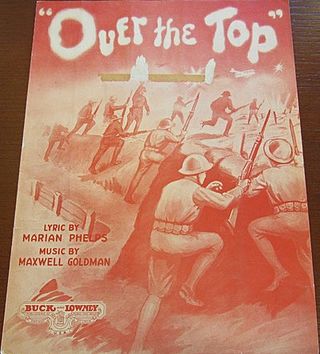
Over the Top is a World War I song written by Marion Phelps and composed by Maxwell Goldman. The song was first published in 1917 by Buck & Lowney in New York, NY. The sheet music features soldiers crawling from a trench and attacking.
Salvation Lassie Of Mine is a World War I song written by Jack Caddigan and Chick Story. The song was first published in 1919 by Leo Feist, Inc. in New York, NY. The sheet music cover features a photo of a Salvation Army nurse with soldiers entering a Salvation Army hut. This song was in the top 20 charts in March and April 1919, reaching number 18 in April.
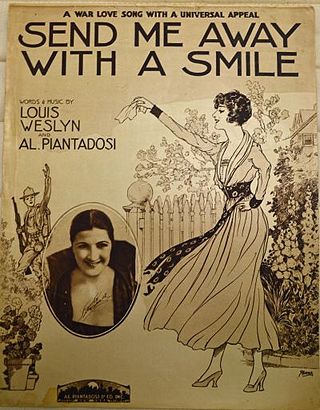
Send Me Away With A Smile is a World War I song written by Louis Weslyn and composed by Al Piantadosi. The song was first published in 1917 by Al. Piantadosi & Co., Inc. in New York, NY. The sheet music cover depicts a woman waving to a soldier from a fenced yard with an inset photo of Rita Gould.
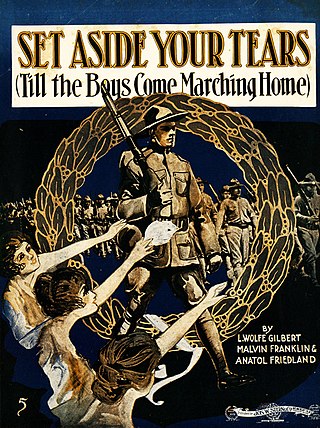
Set Aside Your Tears (Till the Boys Come Marching Home) is a World War I song written and composed by Wolfe Gilbert, Malvin Franklin, and Anatole Friedland. The song was first published in 1917 by Jos. W. Stern & Co. in New York, NY. The sheet music cover depicts a woman waving to marching troops.

Let's All Be Americans Now is a World War I song written and composed by Irving Berlin, Edgar Leslie, and George W. Meyer. The song was first published in 1917 by Waterson, Berlin & Snyder Co., in New York, NY.The sheet music cover depicts a soldier with his rifle and silhouetted marching soldiers in the background. A popular recording in 1917 was made by the American Quartet.
Under the American Flag is a World War I song written by Andrew B. Sterling and composed by Harry Von Tilzer. The song was first published in 1915 by Harry Von Tilzer Publishing Co. in New York, NY. The sheet music cover features a man hugging a woman with an inset photo of Harry Von Tilzer.
We'll Knock The Heligo—Into Heligo—Out Of Heligoland! is a World War I song written by John J. O'Brian and composed by Theodore Morse. The song was first published in 1917 by Leo Feist Inc., in New York, NY. The sheet music cover depicts a terrified Kaiser standing on a cliff with a city below and United States soldiers rushing toward him.
When the Flowers Bloom On No-Man's Land is a World War I song written by Howard E. Rogers and composed by Archie Gottler. The song was first published in 1918 by Kalmar, Puck, & Abrahams Music Co., in New York, NY. The sheet music cover depicts soldiers marching with an inset photo of Fred Weber. The sheet music was later reprinted with an inset photo of Dorothy Jarrett.
Where Do We Go From Here? is a World War I song written by Howard Johnson and composed by Percy Wenrich. The song was first published in 1917 by Leo Feist, Inc., in New York, NY. The sheet music cover features a photo of Collins and Harlin.
You Keep Sending 'Em Over and We'll Keep Knocking 'Em Down is a World War I song written by Sidney D. Mitchell and composed by Harry Ruby. The song was first published in 1917 by Waterson, Berlin & Snyder Co., in New York, NY. The sheet music cover depicts a soldier on top of a trench ladder uses his rifle as a club with an inset photo of Eddie Cantor.











